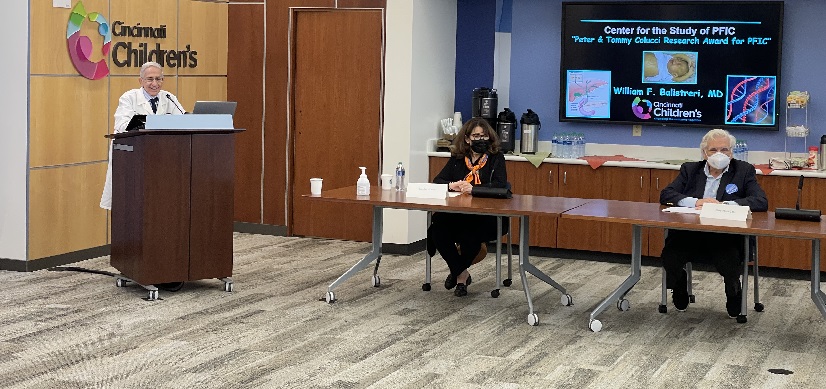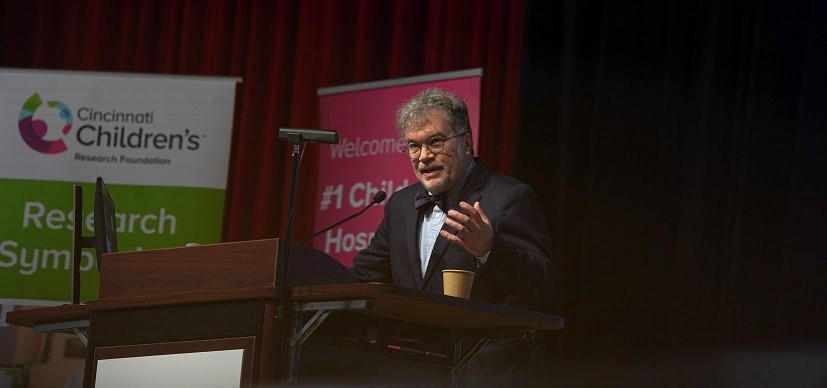Cincinnati Children’s Launches Research Center for Rare Liver Diseases
Post Date: December 6, 2021 | Publish Date:

Children and families affected by progressive familial intrahepatic cholestasis (PFIC)—a group of rare genetic liver diseases—face many difficult questions. What caused the disease? How will it impact their health? Which treatments will work?
Now, a first-of-its-kind research center at Cincinnati Children’s is dedicated to finding answers for patients with PFIC and related diseases.
Launching in January 2022, the PFIC Research Center focuses on translational and clinical research to improve outcomes and seek a cure for these diseases. Integrative approaches—including in vitro studies, in vivo modeling, clinical trials, and a comprehensive patient registry—will lead to novel therapies and reduced need for liver transplantation for children with PFIC.
The Center is funded by a $1.5 million gift from the Peter and Tommy Fund, which was established by the Colucci family after losing two young boys to PFIC in the 1960s and 70s. Although Peter and Tommy were unable to benefit from modern research, their family never stopped searching for answers.
Fighting PFIC
People with PFIC usually begin to experience symptoms in infancy. Often, one of the first signs is jaundice, followed by severe and debilitating itching. Other signs may include poor growth, portal hypertension, enlargement of the liver and spleen, bleeding or easy bruising, and deficiencies in vitamin A, D, E, and K.
These symptoms are caused by a blockage of draining bile from the liver to the intestine, meaning that toxins in bile remain in the liver. This causes damage to liver cells and a buildup of waste in the bloodstream. Without treatment, PFIC can lead to cirrhosis and end-stage liver disease. As most patients may eventually require a liver transplant, current therapies focus on minimizing growth failure and decreasing discomfort while they wait for surgery.
When Peter Canisius Colucci and Thomas Aquinas Colucci were born, the liver transplants that may have saved their lives were unheard of. In 1968, Tommy passed at the age of 5. Peter passed in 1973 at the age of 13. The next day, the Colucci family learned that surgeons had performed the first liver transplant.
Carmela Colucci, the boys’ mother, set out to do everything she could to help other children and families fight this battle. She went on to establish the Peter and Tommy Fund in the 1980s, which supports clinical research and treatment of pediatric liver disease.
During this time, Carmela Colucci met William Balistreri, MD, an expert in liver disease at Cincinnati Children’s. After discussing PFIC in-depth and sharing Peter and Tommy’s story, they began a years-long collaboration. In 2020, the Colucci family reached out to Balistreri to develop a new plan—establishing a PFIC Research Center.
Pioneering Discoveries
For more than 25 years, the Liver Care Center at Cincinnati Children’s has provided expert care for children with PFIC. They were the first pediatric center to develop a clinical diagnostic test to screen for gene mutations, and were early adopters of new external and internal biliary diversion procedures to decrease itching.
In the lab, researchers at Cincinnati Children’s are using human tissues, stem cells from patients, mouse models, and unique zebrafish models to study PFIC. These innovative approaches are giving insights into the cellular causes of PFIC, different types of genetic mutations, and new pharmacologic therapies to improve liver function.
The new PFIC Research Center builds on this expertise to incorporate clinical care, research, advocacy, and educational components. The interdisciplinary team will work to engage patients and families, secure sustainable funding, and foster collaborative research projects.
“For any basic researcher, it is a dream to be able to bring research from bedside to bench and back,” says Chunyue Yin, PhD, a developmental biologist at Cincinnati Children’s. “This new Center makes it a reality by bringing a team of physicians, geneticists, and basic researchers together to study PFIC. To me, it has been especially rewarding to see my research in animal models lead to the discovery of a new gene and variant in PFIC and a new potential treatment strategy for patients. With support from the PFIC Research Center, we will be able to continue and extend prior successes and truly improve patient diagnosis and outcomes.”
Short-term goals of the Center include building a patient registry, establishing a PFIC-dedicated clinic, and developing new drugs to potentially halt the progression of disease. In the long term, the team plans to run pre-clinical studies of therapeutic agents, as well as establish a national-international alliance for clinical PFIC research.
“For patients and families, we will work together to find answers—from identifying genetic causes for the disease, making a diagnosis, and providing personalized therapies,” says Akihiro Asai, MD, PhD, a pediatric hepatologist and researcher at Cincinnati Children’s. “In the future, gene therapy is a promising tool that will bring us closer to a cure, but there are a lot of barriers before this becomes a reality. We are fully equipped and energized to tackle these barriers.”
Ultimately, the new PFIC Research Center aims to fulfill Carmela Colucci’s wish in memory of her sons—that no child will suffer or die from pediatric liver disease.
“When we opened the Liver Care Center in 1985, everyone was excited about liver transplantation—and as excited as I was about establishing that program, I’ll be more excited when we close because we have found cures for these diseases,” Balistreri says. “I feel the same way about the PFIC Research Center. We want to find causes and cures for these patients.”
Learn more about liver disease research at Cincinnati Children’s.
Learn more about Cincinnati Children’s designation as a NORD Rare Disease Center of Excellence.






